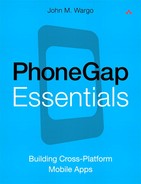Foreword: By Bryce A. Curtis
Everywhere you go, people are using mobile devices to keep in touch with family and friends, to find a nearby restaurant, or to check the latest news headlines. Their phones have become an indispensable part of their lives with applications that bind them closer to each other and the world around them. It’s these applications that make their phones truly useful. Most users aren’t aware of the underlying technology used to develop their favorite app or how much time it took to write. Instead, they view an application in terms of the benefit it provides them. Therefore, as developers, we are free to select technologies that deliver this benefit in the most efficient manner.
One technology decision that must be made early on when developing an application is whether it is to be written using native or web APIs. Depending upon the application, native APIs may be required to meet the user’s expectations. However, for most applications, web technologies consisting of HTML 5, JavaScript, and CSS provide equal user experiences. The advantage of using web APIs is that they are written using web technologies familiar to many developers, thus providing an easier and quicker development process. In addition, since web technologies are standardized, they exhibit fairly consistent behavior across the many different mobile platforms available today, such as Android and iOS phones and tablets.
One significant difference between native and web applications is that the native applications provide extensive access to device features such as the camera and accelerometer, while the web applications are limited to what the device’s web browser supports. To bridge this gap between native and web, a new type of application called the hybrid application was created. A hybrid application is written using the same web technologies—HTML 5, JavaScript, and CSS—but includes additional code that enables native APIs to be called from JavaScript. It works by wrapping your web code with a web browser and packaging both together to create a native application.
This book focuses on how to develop mobile applications using PhoneGap, which is a popular open source toolkit for building hybrid applications. You investigate the extensive PhoneGap API and learn how to include many of the device features in your applications. It will become apparent that PhoneGap delivers on the promise of a simplified, cross-platform mobile development by enabling you to write your application using web technologies and then packaging it up so that it can be distributed throughout the various app stores and markets. With any luck, your application may even become someone’s favorite app.
BRYCE A. CURTIS, PH.D.
Mobile & Emerging Technologies
IBM Master Inventor
IBM Software Group
